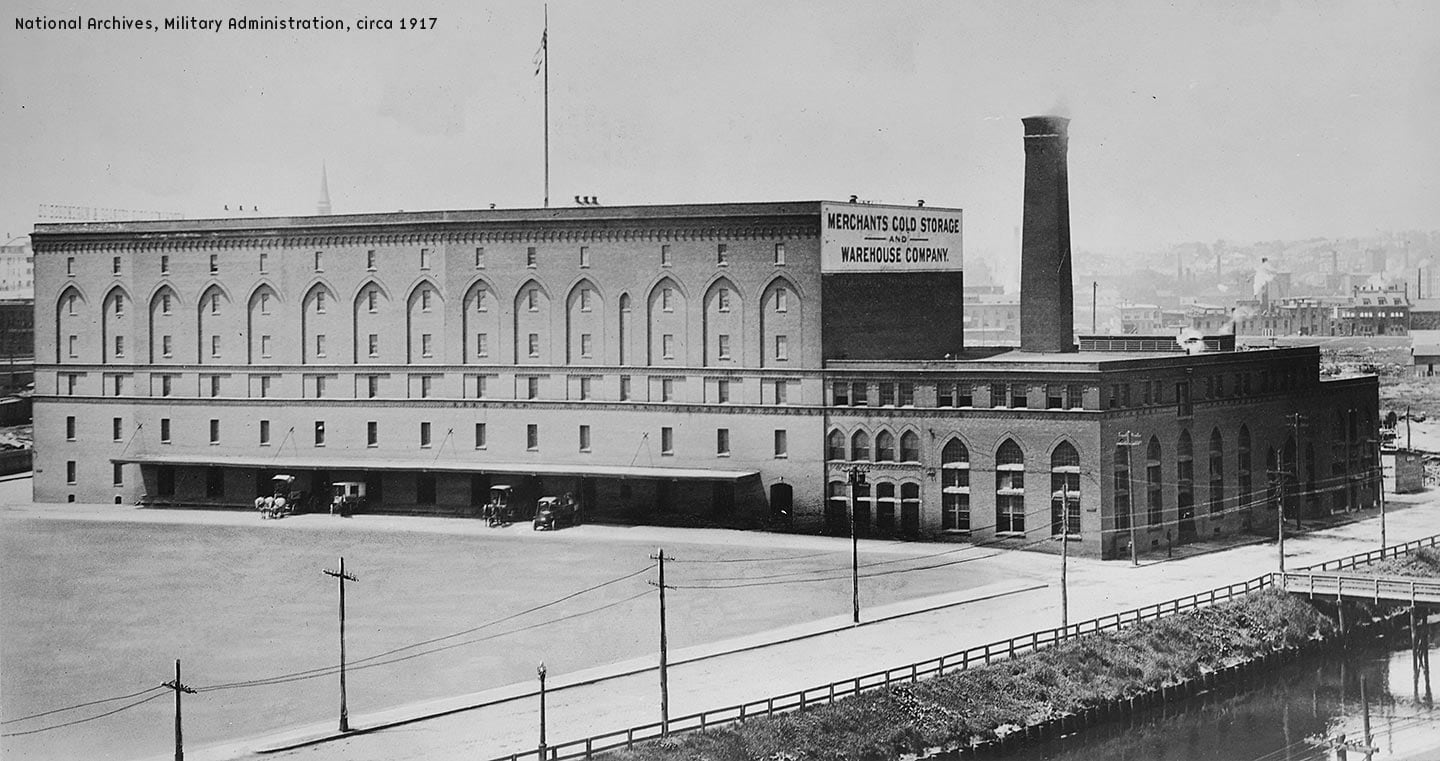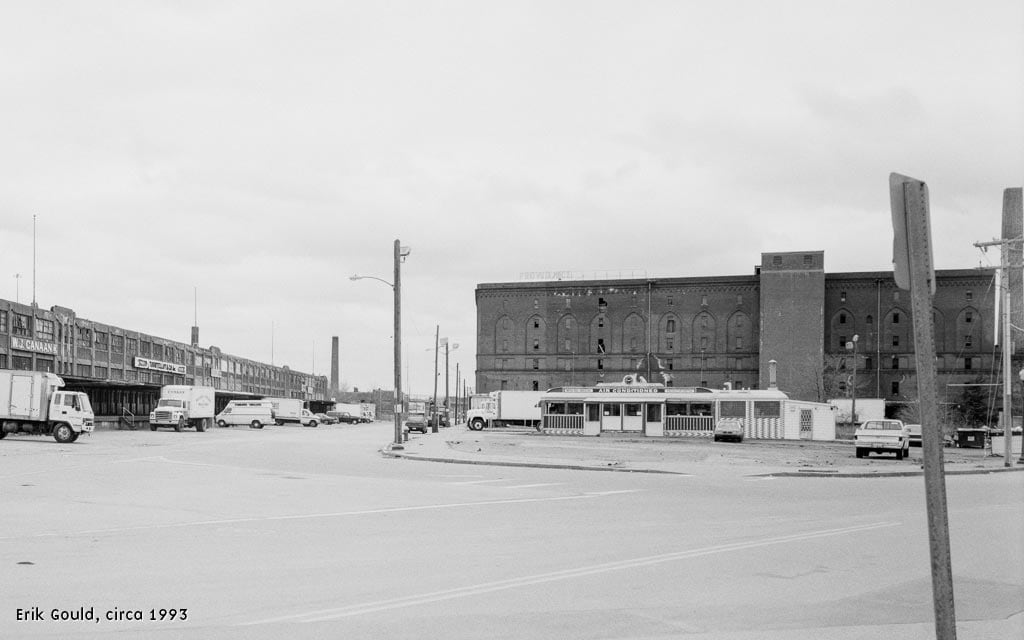Merchant’s Cold Storage and Warehouse Company
also known as Providence Cold Storage
This imposing, 6-story cold storage facility ran continuously for 98 years. It fell to the wrecking ball before converting these buildings became the cool thing to do
images of this Property
-

National Archives, Military Administration, 1917-1918 -

John Hutchins Cady Research Scrapbooks Collection, Providence Public Library, circa 1940 (guess) -

1910 Wolf-Linde Compressor and 14-foot engine flywheel, side view — Steve Dunwell, Photographer, March 1979 -

Cylinder of 1910 Wm. A. Harris engine with Corliss valve gear — Steve Dunwell, Photographer, March 1979 -
![]()
Cross-head, connecting rod, and flywheel of 1910 Wm. A. Harris engine — Steve Dunwell, Photographer, March 1979 -
![]()
Crank, connecting rod, bearing and flywheel of 1910 Wm. A. Harris engine — Steve Dunwell, Photographer, March 1979 -
![]()
Photo by Erik Gould, circa 1993 -
![]()
Photo by Erik Gould, circa 1993 -
![]()
Photo by Erik Gould, circa 1993 -
![]()
Photo by Erik Gould, circa 1993 -
![]()
-
![]()
-
![]()
-
![]()
-
![]()
-
![]()
-
![]()
-
![]()
-
![]()
-
![]()
-
![]()
-
![]()
22 images: Press to view larger or scroll sideways to see more. Contributions by the John Hutchins Cady Research Scrapbooks Collection at the Providence Public Library, Steve Dunwell, Virginia Adams & Anne Tait, and Erik Gould
About this Property
Reason for Demolition
The Merchants Cold Storage Warehouse was demolished in 1998-2000 as part of the redevelopment of the old Cold Storage Provisions Warehouse District for increased residential use. The sign on the roof — at least 6’ tall letters spelling “Providence Cold Storage” — looks to have been removed shortly after the company became defunct, about 1993. It was one of the first buildings to be razed in the district, followed by the Providence Fruit Warehouse, A.T. Armour, and Brownell and Field.
It’s too bad that this building was gone right before the trend became turning them into housing or other commercial functions. The building’s thick insulated, sound-dampening walls would have made a perfect host for music practice spaces or even a few dance clubs. There is a similar building (built for the same use) in Paris that has been transformed into band practice and recording studios. It’s even worse that it was replaced by a building that won’t last the same 100 years that the Cold Storage building did.
Current Events
Jefferson Place, now called the 903, occupies the former location of this building as well as the former location of the Silver Top Diner.
History
The amazing circa 1917 photograph was found in the National Archive as part of the Military Administration: In Service of the Interior collection. Another interesting postcard (?) image is held at Wikimedia but the moire pattern of the scan makes some of the architectural detail hard to discern.
From the RIHPHC survey of Providence Industrial Sites, July 1981
The Merchants’ Cold Storage and Warehouse Company built this large, and architecturally impressive, warehouse in 1893, and continues to operate it. The warehouse is brick with recessed Gothic arches, corbeled belt courses, and drip mouldings. Opened for business in June 1894, the building originally contained 300,000 cubic feet of refrigerated space carried on substantial woOd beams and posts, a framing system which remains intact. Located in the middle of Providence’s produce district, the warehouse was primarily used for the storage of eggs, butter, cheese, apples, and assorted dry fruits. With its storage space increased to 3,000,000 cubic feet by 1910, Merchants’ was the largest cold storage plant in New England outside of Boston.
Refrigeration was maintained through a system of brine circulation involving the use of three brine tanks; three ice machines, or compressors, driven by steam engines an extensive net work of circulating pipes; and an assortment of pumps, boilers, and auxiliary equipment. Two of the three Linde Ice Machines patent dates, 1880 and 1884, built by the Fred W. Wolf Company of Chicago, are still in place though no longer used. The Number 2 machine, 15” X 25” with 75-tons capacity, was driven by a Harris Corliss high-pressure steam engine, 18” X 42”. This steam engine-compressor set, which remains in place, was installed in 1893.
In 1910, a larger set was installed and that too, survives. The ice machine is 16” X 30” with a 100-ton capacity and the Harris-Corliss is 32” X 42” with a 14-foot flywheel; The two steam engine-compressor sets, recently painted and with their brass fittings polished, are exceptionally well- preserved. Brine recirculation is still employed, though the system now uses York automatic compressors, installed in the late-1950s, with a 500-horsepower Carrier centrifugal compressor, c.l946, in stand-by. The original -hydraulic elevators continue in limited use. After World War -II, the company converted its cooling units to freezers to meet the growing market for frozen foods.
With modernized hatcheries eliminating the seasonal nature of the egg business, Merchants’ no longer stores shell eggs. The warehouse, with its own active rail spur, currently stores meat, poultry, and cranberries. Merchants’ is an excellent surviving example of 19th-century cold storage technology. (Board of Trade Journal, Providence, September 1910, illustrations; Interview with Carl Johnson, manager, August, 1977; Jenks and Ballou, “List of Apparatus and Notes on Design, Operation and Management of the Power Plant of the Merchants’ Cold Storage and Warehouse Company,” February, 1953.)
National Register nomination prepared by Anne Tait and Virginia Adams, 1994, for the Public Archeology Lab, Pawtucket
The Merchants Cold Storage and Warehouse Company began this large, and architecturally impressive warehouse in 1894 and closed its doors in 1992. The six story warehouse was constructed of solid brick walls with recessed gothic-revival style arches, corbeled belt courses, and drip mouldings, all capped by a flat roof. The building originally contained 300,000 cubic feet of refrigerated space carried on substantial wood beams and posts, a framing system used throughout subsequent additions to the building in 1896 and 1899.
In 1893 Israel B Mason purchased 90,000 sq ft of space on Kinsley Ave to build a state-of-the-art cold storage warehouse. It opened for business on June 1, 1894, with 840,000 cubic feet of space. It was increased to 1,260,000 cubic feet in 1896, and again to 1,800,000 in 1899. It was officially named “Merchant’s Cold Storage Warehouse Co.” in 1911. In 1992, the business closed and was defrosted for the first time in its 98 year history.
Designed by Stone Wilson and Carpenter in 1894, the earliest section of the MCSW lies on the Kinsley Avenue (north) side of the lot. It was eight bays on the north, by eight bays on the west, by six bays on the east. The south elevation possesses the most elaborate vocabulary of architectural ornament on the building, including large, two-story wood sash topped with pointed Gothic arches with decorative brickwork. A belt brick course ran between the second and third stories, and a brick corbelled cornice ran along the roof line. Third story windows were 6/6 wood, double hung sash. Rusticated stone work was used for sills, foundation, and stairs. This section held the three story boiler room, engine room, offices, and tank room.
The six story cold storage area is comprised of five sections, with solid wood beams and a maze of pipes mounted to the ceiling that carried chiilled brine (salt water) throughout the facility. Walls were composed of two layers of wood holding either cork or mineral wool for insulation.
Until 1993, many components of the buildings mechanical support systems remained in place. The 1894 section included boilers, Harris Corliss high pressure steam engines, and three Linde Compressors built by Fred W. Wolf of Chicago. One Harris Corliss steam engine is now stored at the Slater Mill National Historic site in Pawtucket, and measures 32” x 42” with a 14’ flywheel. In 1910, a larger refrigeration set was installed alongside the original equipment. The ice machine was 16” x 30” with a 100 ton capacity. A more efficient system was installed in the 1950s, including a York automatic compressor, and a 500hp Carrier centrifugal compressor, circa 1946.

















